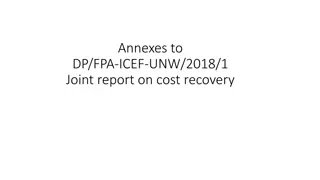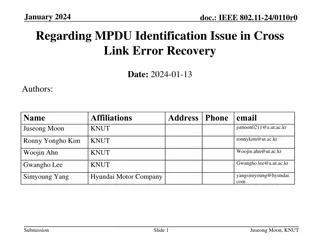The Recovery of Dang Thuy Tram and Her Diaries
Dang Thuy Tram's recovery and the return of her diaries played a significant role in post-war reconciliation between the United States and Vietnam. The diary's journey from being saved by a US soldier to its publication in Vietnam sheds light on the complexities of memory, war, and identity. Tram's diaries became a symbol of patriotism and truth-telling, resonating with readers on both sides of the conflict. The process of returning the diaries highlighted personal connections and the power of shared humanity in overcoming the wounds of war.
Download Presentation

Please find below an Image/Link to download the presentation.
The content on the website is provided AS IS for your information and personal use only. It may not be sold, licensed, or shared on other websites without obtaining consent from the author.If you encounter any issues during the download, it is possible that the publisher has removed the file from their server.
You are allowed to download the files provided on this website for personal or commercial use, subject to the condition that they are used lawfully. All files are the property of their respective owners.
The content on the website is provided AS IS for your information and personal use only. It may not be sold, licensed, or shared on other websites without obtaining consent from the author.
E N D
Presentation Transcript
DOCTOR, WOMAN, ENEMY: RECOVERING THE LIFE OF DANG THUY TRAM IN LAST NIGHT I DREAMED OF PEACE. JOHN CASEY UNIVERSITY OF ILLINOIS AT CHICAGO
DANY THUY TRAMS RECOVERY As with most wars, the passage of time lessened the desire to forget the Vietnam/American War and manage those memories allowed to rise to the surface. Improved economic and political relations between the United States and Vietnam helped in this process. On July 11, 1995, President Clinton announced the normalization of US political relations with Vietnam. Since then, US tourism to Vietnam has grown as well as the import and export of goods from that country. The recovery and reception of Tram s diary is best understood within this context.
DANY THUY TRAMS RECOVERY (CONT.) Most early reviews of the diary (scholarly and non-scholarly) focused on the way the diary was saved by a US soldier from destruction. The introduction to the first US edition describes how Fred Whitehurst, a lawyer who had served with a military intelligence detachment, (xvi) was reviewing captured enemy documents for possibly useful intelligence. What wasn t useful would be burned. When he came across Tram s diary his interpreter supposedly told him Don t burn this one, Fred. It has fire in it already (xvi). Whitehurst kept the diary and a second one found not long after, bringing them home with him at the end of his tour of duty.
DANY THUY TRAMS RECOVERY (CONT.) We also learn in the introduction that Whitehurst waited until his retirement from a job at the FBI to attempt returning these diaries to Tram s family. Ostensibly because he was afraid in his role as an FBI agent it might look suspicious approaching the representatives of a foreign government with print documents. It also seems clear, however, that Whitehurst had to wait for the write moment to release his memories as well as those of Tram. He returned the diaries to Tram s mother in April of 2005.
DANY THUY TRAMS RECOVERY (CONT.) Tram s diaries were published in Vietnam not long after their return (July 18, 2005). She became an instant hero and her book set sales records. Vo Hong Chuong Dai, a Vietnamese poet and cultural critic, notes that more that 450,000 copies sold. An average book run would be closer to 2,000. In the United States, translation made the book s release slower. A first edition appeared in 2007 translated by Vietnamese-American author Andrew X. Pham. Here the book received good initial critical praise but no were near the public attention accorded to more traditional Vietnam War narratives like The Things They Carried (1990).
WHAT EXACTLY WAS RECOVERED? In the United States Tram s status as a woman overshadowed her other identities in the narrative. The introduction to the US edition of the diary tells us that Fred Whitehurst chose to keep the book because Human to Human, I fell in love with her (xvi). Vo Hong Choung Dai notes that in Vietnam her diaries set a model for skeptical patriotism that allowed people to air grievances against certain individuals within the leadership structure, all the while reaffirming ones commitment to the country and the party system (203). In both countries, her narrative presented the possibility of national reconciliation between enemies brought about by a female martyr.
WHAT WAS LOST Missing from this discussion of Tram s femininity and the national attempts to use her gender for political rapprochement is the fact that Tram was highly educated. Both of her parents were surgeons in Hanoi and Tram was on track to become an eye surgeon before volunteering to serve as a military doctor in charge of a field hospital in south central Vietnam. She tells us in her diary that I alone am responsible for managing the clinic, treating the injured, teaching the class (i.e. training nurses) (37). We also come across entries in her diary of surgical operations she conducts under less than ideal conditions (see next slide).
WHAT WAS LOST (CONT.) In a diary entry for April 8, 1968 she says: Operated on one case of appendicitis with inadequate anesthesia. I had only a few meager vials of Novocain to give the soldier, but he never groaned once during the entire procedure. He even smiled to encourage me. Seeing that forced smile on lips withered by exhaustion, I empathized with him immensely. Even though his appendix had not ruptured, I was very sorry to find an infection in his abdomen. After a fruitless hour of searching for the cause, I could only treat him with antibiotics, insert a catheter, and close the wound. A whirl of emotions unsettled me: a physician s concerns and a comrade s compassion and admiration for this soldier. Brushing the stray hair back from his forehead, I wanted to say, If I cannot even heal people like you, this sorrow will not fade from my medical career (Tram, 4).
WHAT WAS LOST (CONT.) Regrettably, Tram s medical journals were not saved. There she documents in exhaustive detail what worked and what didn t in her attempt to treat North Vietnamese soldiers. Those details would have greatly complicated the postwar urge to make her into a saintly nurse rather than an overworked and idealistic surgeon. Also lost is what exactly constitutes the fire that made her diaries (according to Whitehurst) worth saving. Most critics simply repeat this assertion without giving an example.
WHAT WAS LOST (CONT.) A diary entry for August 27, 1968 presents one example of that fire: A critical operation is successful, a ruptured kidney mended. The bleeding has stopped; the patient s urine has become clear and normal. A life saved should be a great joy, but somehow I feel apathetic and inadequate before my smiling patient, unmoved by his respectful eyes. Is it because I know I have stemmed but one bloodflow while countless others are still bleeding? I must mend all the wounds of our nation. The Americans are upon us like bloodthirsty devils, stealthily sinking their fangs into our bodies. Only when we have chased them all out of Vietnam will our blood stop pouring into the earth (Tram, 47).
WHAT WAS LOST (CONT.) This passage shows Tram s exhaustion as a doctor asked to work miracles in a medical setting that is much worse than that experienced by her American counterparts. It also shows her politicized love for her nation and its people. Both are firey expressions of her hope and frustration. However, the true fire in this passage can be found in the metaphor. Tram reminds American readers here that we are the enemy. A parasite sucking the life out of her homeland. Her battle is thus as much biological as it is political. To heal the body of Vietnam from its invading host.
WHAT WAS LOST (CONT.) Another moment where the poetic quality of Tram s firey writing style appears is in a diary entry for August 5, 1969: I m on a night emergency-aid mission, going through many dangerous parts of the national highway on which enemy vehicles frequently commute, and passing through the hills filled with American posts. Lights from the bases shine brightly; I go through the middle of the fields of Pho Tuan Perhaps I will meet the enemy, and perhaps I will fall, but I hold my medical bag firmly regardless (146).
WHAT WAS LOST (CONT.) Here Tram creates a vivid scene that reminds us that combat and non-combat roles are not easily separated in war. Due to a shortage of personnel, the clinic s surgeon is moving along in the dark within clear view of US forces at a well lit base. She is bringing her medicine to a soldier too sick to come to her. Tram s language is vivid here and highlights for readers the self-conscious sacrifice she is making for the betterment of her country.
WHAT HAPPENS NEXT? Tram s life far exceeds her status as a woman or an enemy for US readers. She was a doctor and her narrative belongs within that venerable tradition of war literature. Her diary also shows how women s narratives have been pushed to the edges of war literature where they are allowed to be in subsidiary roles but never seen as people with agency on the battlefield. Future studies of Tram should follow the lead of Alison M. Johnson whose dissertation Herstories of War: Representations of Silence in Women s Vietnam/American War Narratives (2016) helps restore some of that agency.
WHAT HAPPENS NEXT? This task is especially important as a generation of veterans (many of them women) write about their experiences in the ongoing Global War on Terror (GWOT). Literature changes to meet the hopes, fears, and desires of each generation. Criticism must evolve to account for those changes. War narratives cannot be the same as they have always been. Neither can our criticism of them.
FURTHER READING Tram, Dang Thuy. Last Night I Dream of Peace: The Diary of Dang Thuy Tram. New York: Harmony Books, 2007. Johnson, Alison M. Herstories of War: Representations of Silence in Women s Vietnam/American War Narratives. Dissertation. University of North Carolina Greensboro, 2016. Chuong-Dai, Vo Hong. Memories that Bind: Dany Thuy Tram s Diaries as Agent of Reconciliation. Journal of Vietnamese Studies. 3(2): 196-207. Taylor, Sandra C. Vietnamese Women at War: Fighting for Ho Chi Minh and the Revolution. Lawrence, KS: University Press of Kansas, 1999.























